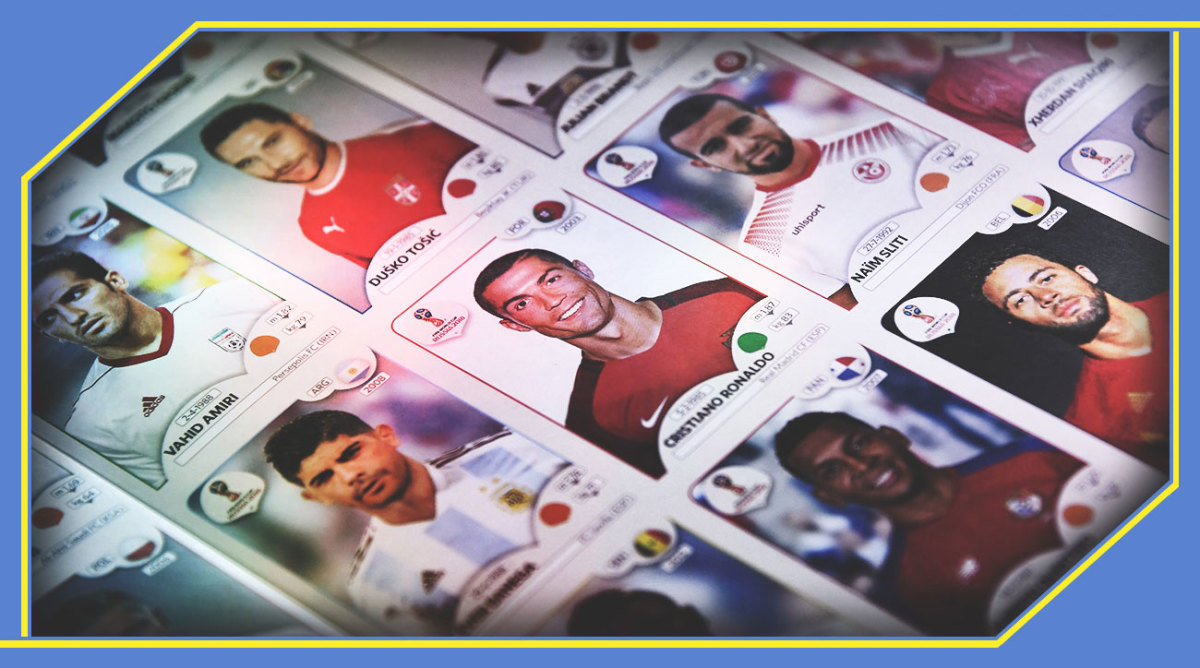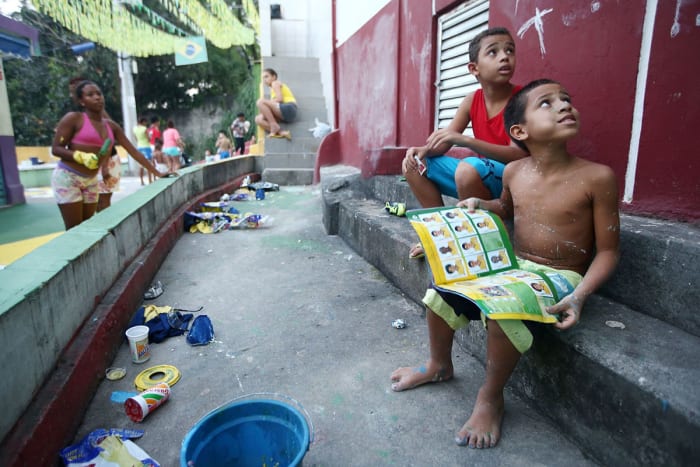The Magic, Global Craze and Tradition of Panini's World Cup Sticker Albums

Welcome to the wonderful world of Panini World Cup sticker albums, a cultural, soccer tradition that spans more than 50 years, attracting and creating millions of soccer fans around the globe.
Since Panini formed a partnership with FIFA and published the first album as part of the 1970 World Cup in Mexico, the multi-generational phenomenon of collecting and trading stickers has become a vital part of the tournament’s experience.
When you’re a collector, albums are treated like heirloom pieces, and every four years, people congregate in their homes, neighborhoods–and now online–to form a unique bond of sticker trading.
Having originated in Italy by two brothers in 1961, the world of Panini has grown into a global love affair with collecting and trading stickers of World Cup teams and their players. Due to social media and reliance on digital content, Panini developed an app for Russia 2018, where fans have the chance to collect and swap virtual stickers in an online album. The application has averaged between 50,000 to 60,000 downloads a day, reaching more than 1.5 million users.
The beauty of Panini, however, is with the physical album, because it connects the fan to the World Cup, both as a sticker collector and a devotee to history.
In 2010, Panini sold more than 10 million packs in the U.S. alone, thanks in large part to the country’s Latino community, where immigrant parents–whether it’s Colombia, Peru, Argentina, Mexico or Brazil–pass on their love to their children, creating a timeless passion and family tradition.
Open up a pack and step inside the craze that captivates the world come every World Cup.
BEHIND THE SCENES OF PANINI WITH CEO MARK WARSOP
Panini America CEO Mark Warsop has been involved with collecting almost his entire life. While Warsop was growing up, his father worked for the main distributor of Panini U.K. and would bring stickers home for his son to collect. He remembers the España 1982 World Cup as the one that piqued his interest and where he really understood what was going on as he followed his home country, England.
There are Panini cards and stickers for other moments, but what is it about the World Cup that makes it such a big deal, and something completely different?
The thing about the World Cup is it’s just an absolute global phenomenon. The backbone of our business has been built on back of the World Cup since the early ‘70s when we did our first collection in 1970. It’s just grown in strength from tournament to tournament. It’s the one sport that’s just followed by every country on the planet.
The book can then be a treasured keepsake that you can keep, hand down to your children, and then they can collect and hand thiers down to their children.
Which is why (with) the World Cup, we have so many adults who actually step in and do sticker collections, because they remember doing España ‘82, they remember doing Mexico ‘86 and then they’re reliving their childhood by collecting.
What’s the process like for preparing for a World Cup, and how’s that changed while you’ve been with the company and soccer has expanded rapidly in the U.S.?
For us, the process for World Cup just never stops because we buy the rights from FIFA and that gives the right to use all the official symbology, the mascot, the stadium, obviously the FIFA logos and the name of tournament. But we then have to go out and have licensing arrangements with each individual national team that is participating in the tournament. process.
From a U.S. perspective, obviously we’re very disappointed that the U.S. didn’t qualify, we were really hoping that would be the case, but in the U.S., probably about 85 percent of our collectors are Hispanic or Latin American in origin, so it’s not had an impact on what we’re doing here.
You mentioned the Hispanic and Latino market being about 85 percent, how has it changed the way you’ve developed things over the years or the way you’re strategizing?
It hasn’t changed necessary the way we’ve developed the product itself, but it has changed the way that we market and where we’re selling it. A lot of our marketing activity is targeted toward like Telemundo and Univision and hispanic radio stations and Hispanic media and newspaper giveaways. A lot of community driven promotion within youth soccer leagues and momma-and-papa type stores that do very, very well with the sticker collection who traditionally wouldn’t take a trading card or collectable at all. But they all get behind the World Cup in a big way, so the distribution that we do for World Cup is very different than the distribution we have for our U.S. sports trading cards. That’s been developed a lot over the last 10 years or so.
What are the biggest countries interested in the World Cup Panini sticker album where you had the largest sales?
It’s not surprising from a sales perspective that the largest sales volume that we have from any country is Brazil. They live and breathe soccer, that’s a religion for them. It’s a very large country in terms of population in any case. Overall volume, Brazil is alway No. 1. Another large market is the U.S., England, and Germany. Switzerland stands out being a very, very large market, particularly for the size of population. In fact, if you were to look at sales as a ratio to population, Switzerland probably would be No. 1. But everywhere all over Latin America, there is just a phenomenal volume of packets being sold right now. The one that’s probably up the most is Peru on account they haven’t qualified for a World Cup since '82. For them there right now, this is a particularly special moment, and the volume that we're doing in Peru are off the charts.

Rio de Janeiro, Brazil, 2014. Brazilians gather while painting a section of the Santa Marta favela in Brazilian colors as a boy holds his Panini World Cup sticker album.
Getty Images
Do you think the future of Panini lies in the app or digital collecting or do you think we’ll still have physical cards and book 20 years from now?
I got asked the exact same question eight years ago, just before we launched 2010. And the fact of the matter is as great as digital apps are and they compliment what we do and while certain people love collecting things and playing on the phone, you can never take away the enjoyment of touching the pack, ripping open the packet for real and just revealing what’s inside. I think that’s what’s so special about our product that is really difficult to do fully in digital. Whereas when I got asked that question eight years ago, it was a similar question of “Do you think sticker sales will go down because of the focus on digital,” but what we’ve seen is that 2010 was higher than 2006, 2014 sales grew on 2010 and 2018 sales, even though everyone has a smartphone in their pocket, are going to better than 2014 so we’ve not seen physical slowdown.
What have you seen from Kobe Bryant, a big Panini fan after growing up in Italy, and what has that meant to Panini U.S.?
It’s meant a lot and the fact he did grow up in Italy, and actually, his childhood he remembers collecting more stickers than cards cause he grew up in italy and he collected the Calciatori collection, which is our Italian soccer league collection. So just the fact he understands our business, not just the cards but also the stickers has meant that it’s such a great relationship. When we first came to the US, not many people had actually heard of panini—both collectors and players. The great thing about Kobe is he already knew Panini and he said, “Aw man, I love Panini, I collected Panini when I was a kid.” So that’s what made our relationship with Kobe so special. He understood our business and he actually wanted to have a deal with Panini, whereas at the time, most players didn’t know who we were.
Albums
Mexico, 1970 World Cup
Album specs: 48-page album, 270 stickers
This is Panini’s first World Cup sticker collection. It is multilingual and includes a section dedicated to the tournament’s history.
Germany, 1974 World Cup
Album specs: 48-page album, 400 stickers.
This is the only Panini World Cup album that doesn’t mention the host country on the cover, because Germany was still divided into East and West Germany.
The last pages of the album are dedicated to teams excluded from the World Cup.
Argentina, 1978 World Cup
Album specs: 48-page album, 400 stickers.
This album holds stickers of sketches of host stadiums and pictures of cities in Argentina.
Spain, 1982 World Cup
Album specs: 48-page album, 427 stickers.
Landscape images are replaced with posters dedicated to host cities.
Mexico, 1986 World Cup
Album specs: 48-page album, 427 stickers.
Mexico becomes first country to host the World Cup twice.
The wave is brought to a worldwide audience after being shown on a global broadcast.
Italy, 1990 World Cup
Album specs: 48-page album, 448 stickers.
Cameroon becomes first African team to reach the quarterfinals.
USA, 1994 World Cup
Album specs: 48-page album, 444 stickers.
East and West Germany were merged to form a unified German team for the first time since 1938.
USA sets the World Cup average attendance record.
France, 1998 World Cup
Album specs: 64-page album, 561 stickers.
This is the first 32-team format World Cup, and the “golden goal” rule is introduced for extra time.
South Korea/Japan, 2002 World Cup
Album specs: 64-page album, 576 stickers.
Brazil wins its record fifth World Cup title.
Germany, 2006 World Cup
Album specs: 64-page album, 597 stickers.
This is Germany’s second time hosting the World Cup.
Zinedine Zidane headbutts Marco Materazzi in the chest in the final before Italy beats France in penalties.
South Africa, 2010 World Cup
Album specs: 72-page album, 640 stickers.
South Africa becomes the first African nation to host a World Cup.
Brazil, 2014 World Cup
Album specs: 76-page album, 640 stickers.
Brazil, Italy and Germany are the only three national teams to be featured in all 12 Panini sticker collections for the World Cup from 1970-2014.
Russia, 2018 World Cup
Album specs: 80-page album, 681 stickers.
First World Cup to be held in Eastern Europe.
Panini debuts an app to go along with the physical sticker book.




















